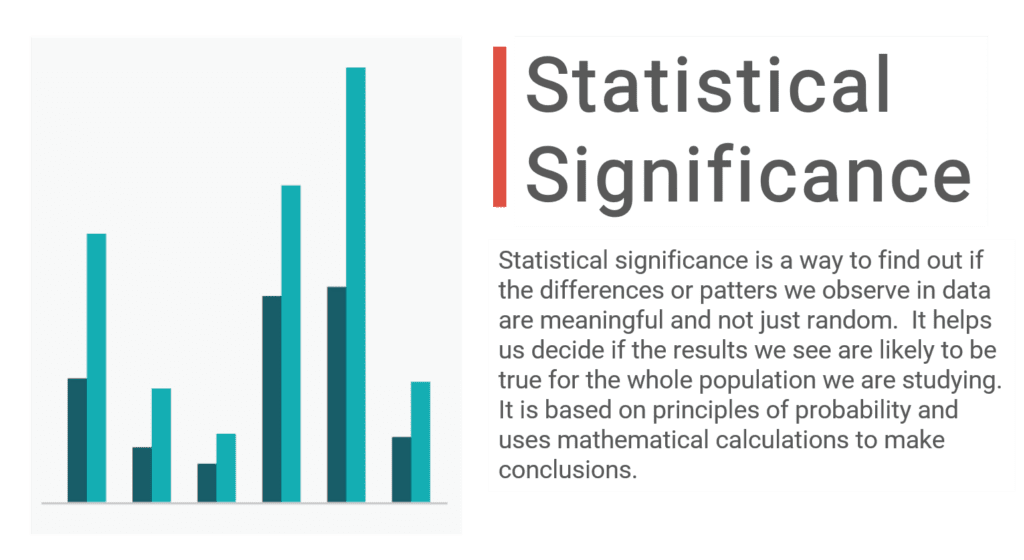In this article, we’re diving headfirst into the captivating world of statistical significance and practical significance. These two concepts hold the keys to unlocking the hidden messages within our data and helping us make wiser choices in our daily lives. It’s like having a superpower that enables us to separate the meaningful from the random coincidences.
Think about it—have you ever had to make a tough decision, like choosing between two hobbies, selecting the best presentation strategies, or even deciding which movie to watch with your friends? Well, statistical significance and practical significance are your trusty companions guiding you toward the right path.
The differences between statistical and practical significance
Statistical significance is the truth detector. It helps us determine if our findings happened by chance or if something is going on. When something is statistically significant, it means that what we discovered in our data probably didn’t occur randomly. We can have more confidence that our results are real and not just a fluke. But here’s the catch: statistical significance doesn’t tell us how big or important the effect is.
Enter . . . Practical Significance
Practical significance addresses real-world impact. Let’s say we test a new medicine that makes a cold slightly shorter, but only by a tiny bit. Sure, the change is statistically significant, but is it really going to make a noticeable difference to someone who’s sick? That’s where practical significance comes in.
The Power of Considering Both: Gain a more complete understanding of our results
To truly understand our results, we must consider the statistical and practical significance. It’s like putting together a puzzle with two important pieces. Sometimes, a finding can be statistically significant, showing it’s not just due to luck but might not have much impact in the real world. On the flip side, some findings might not show up as statistically significant, especially if we didn’t have a large group to study, but they could still be important and meaningful in our lives.
How do we understand and compare the statistical and practical significance of data experiment results or hypothesis tests?
Unlocking the P-Value Mystery
First things first, let’s talk about the mysterious p-value. It’s like a secret code that tells us if our results happened by chance or if there’s something more going on. If the p-value is smaller than our chosen level, often 0.05, it means our results are probably not due to luck. We can confidently say they are statistically significant. In simpler terms, our findings are not just a random event.
Measuring the Magnitude
Statistical significance can sometimes play tricks on us, especially when we have a large group to study. Even tiny, practically unnoticeable differences can be statistically significant. To tackle this, we calculate the effect size. It’s a number that shows us how big the difference or relationship we found really is. Different data types and tests use measures like Cohen’s d, Eta squared, and R squared to help us better understand the effect size.
The Confidence Interval: Our Guessing Range
Imagine having a magical range of guesses. That’s what a confidence interval is! Based on our data, it tells us where we believe the true answer lies. A smaller confidence interval means we have a more precise guess, while a larger one means we’re less certain. If our confidence interval includes zero (for differences) or one (for ratios), then we can’t be sure our finding is statistically significant. But if zero or one is outside the interval, that’s a sign our result is statistically significant.
Bringing It to the Real World
We’ve examined the statistical significance, effect size, and confidence interval, but now we must ask ourselves, “Does it really matter?” This is where practical significance comes into play. Let’s say a new medicine helps people recover just 1% faster. It may be statistically significant, but is it truly important? We need to think about the costs and benefits too. If the medicine is much more expensive or has more side effects, it might not be worth it, even if it’s statistically significant. Practical significance considers the real-life impact of our findings.
Essential tips regarding statistical significance
Tip 1: Look Beyond Significance Testing
One common mistake is fixating solely on whether something is statistically significant, forgetting the importance of effect size and confidence intervals. Ask yourself, “How large is the effect we discovered?” Practical significance considers the size of the effect and its real-world impact. Is it substantial enough to truly matter in practical terms?
Tip 2: Avoid Cherry-Picking
Imagine this scenario: Only showcasing results supporting your preconceived notions while ignoring those not. This selective sharing, known as cherry-picking, can lead to misleading conclusions. To accurately portray your findings, it is crucial to share all the tests you conducted, not just the ones that align with your expectations. Honesty and transparency pave the way for reliable interpretations.
Tip 3: Embrace the Uncertainty
In the captivating world of statistics, uncertainty looms in the shadows. Every number we encounter holds a level of uncertainty. Acknowledging this fact prevents unwarranted certainty in our findings. Remember, there is always some level of uncertainty present in statistical results. Embracing this uncertainty cultivates a curious mindset and encourages further exploration.
Driving Forward with Data: Navigating Automotive Innovation through Statistical Insight
Meet James, a diligent corporate professional navigating the fast-paced world of the automotive industry. As a product manager at a leading automobile manufacturer, James was entrusted with the task of assessing the impact of a recent design modification on the fuel efficiency of their flagship sedan. Eager to make data-driven decisions, James set out to interpret the significance of a comprehensive statistical analysis conducted by the engineering team.
The statistical report sprawled before him, a symphony of numbers and metrics that held the key to unlocking the potential of their new design. James knew that understanding the statistical significance was essential for making informed choices that could shape the future of their product line. Armed with his analytical mind and a resolve to unveil insights, he embarked on his analytical odyssey.
Among the array of charts and tables, a histogram caught James’ eye. It displayed the distribution of fuel efficiency measurements before and after the design modification. A quick glance revealed a shift in the distribution toward higher fuel efficiency ratings after the modification. However, James recognized that the true story lay beyond the visual cues.
Delving into the accompanying statistical tests, James focused his attention on the p-value associated with the observed shift. The report indicated a p-value significantly below the conventional threshold, indicating that the difference in fuel efficiency was highly unlikely to occur by random chance alone. This piqued James’ curiosity and spurred him to scrutinize the confidence intervals.
James was familiar with the concept that a narrower confidence interval indicated greater precision in estimating the true effect. He examined the intervals for the mean fuel efficiency before and after the modification, and to his satisfaction, he found that the post-modification interval was indeed tighter. This meant that the precision of their estimate had improved, adding another layer of confidence to the findings.
Diving deeper, James explored subgroup analyses, as he knew that the design modification might have varying effects on different driving conditions. He honed in on the scatter plot comparing fuel efficiency against speed for both pre- and post-modification data. What caught his attention was that the post-modification data points exhibited less scatter around the trend line, indicating a more consistent improvement across different driving speeds.
Armed with a comprehensive understanding of the statistical results, James walked into the strategy meeting with his team. He confidently explained that the combination of the low p-value, the narrower confidence interval, and the consistency across subgroup analyses provided robust evidence of the design modification’s positive impact on fuel efficiency. This, James argued, warranted a green light for full-scale implementation and further exploration of similar enhancements across their product line.
James’ interpretation of the statistical analysis showcased the power of navigating the nuances within the numbers. By grasping the significance of statistical outcomes, he guided his team toward a strategic decision that could shape the future of their automotive endeavors. Through his narrative, we’re reminded that in the dynamic landscape of corporate innovation, interpreting statistical analysis is akin to wielding a compass that points to the path of progress – and James proved himself a skilled navigator.

